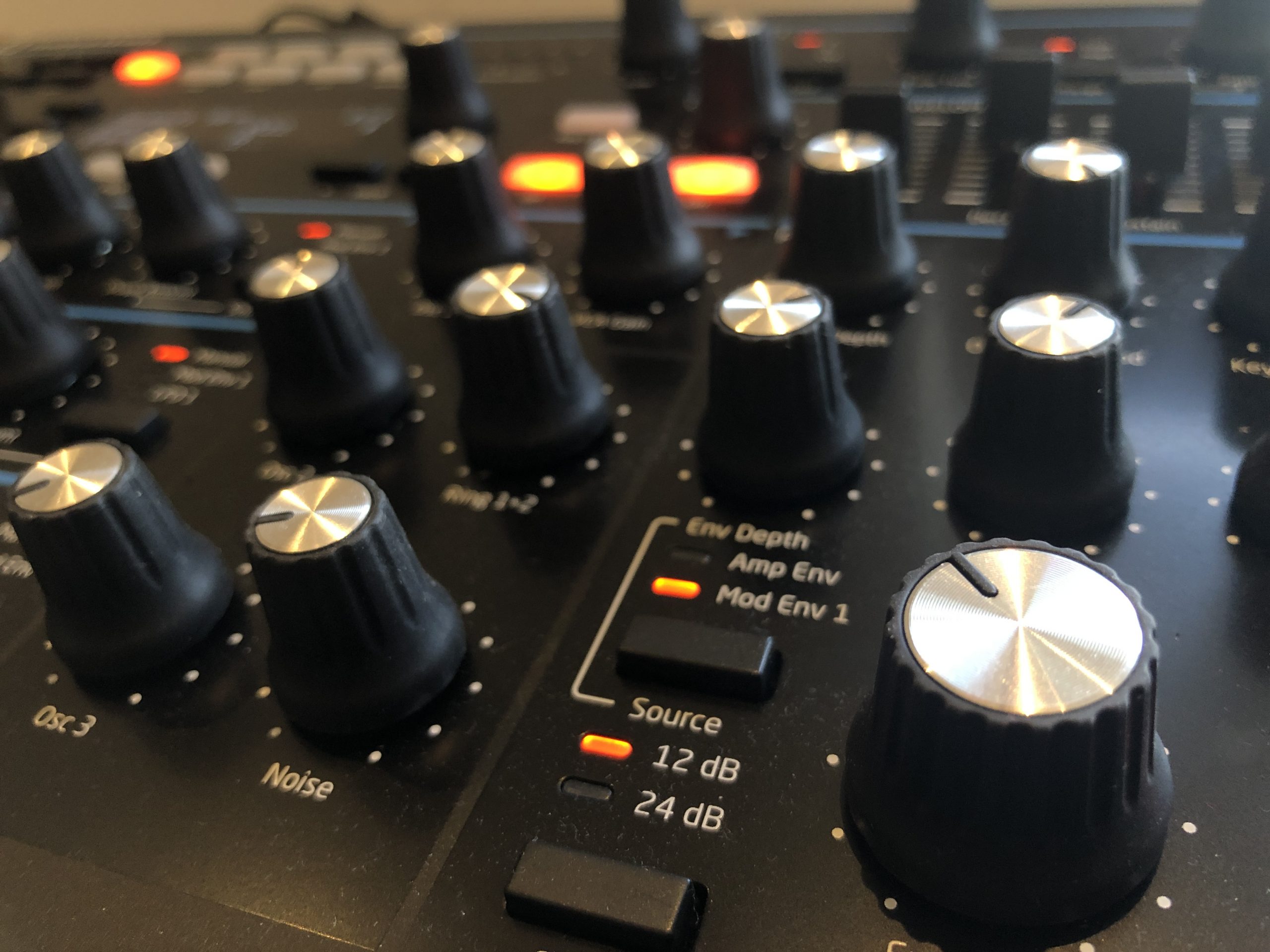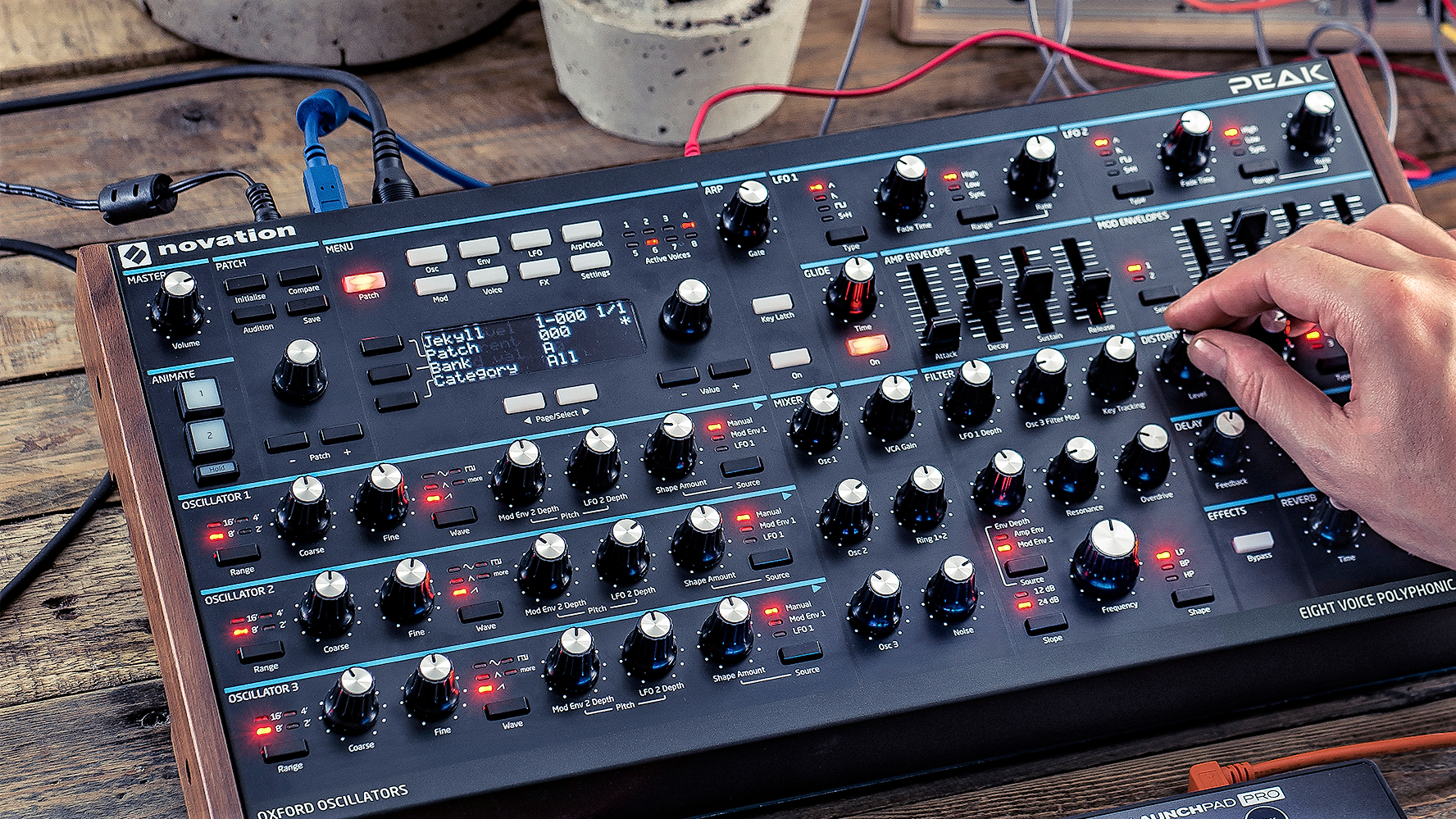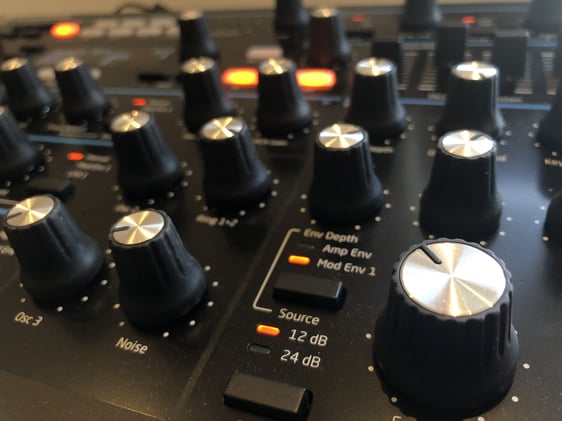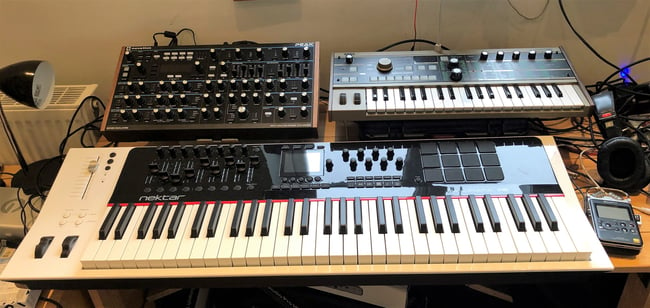
 Novation Peak Synthesiser
Novation Peak Synthesiser
The Novation Peak is an affordable "analogue" synthesiser that's a great place to start making electronic music for films and other video productions Here's our review
Synthesiser music is an essential part of the science fiction film genre. The vast palette of sonic strangeness from these modern-day instruments lends an air of other-worldliness to any production. The sounds can also be inspiring, unsettling and even terrifying. Short of having your own orchestra and sound effects department, there’s no other resource that gives so much for so little.
You don’t have to be a musician to make synth music and effects. Sometimes an individual sound can be a soundtrack in itself. But if you have a little - or a lot - of musical ability, there’s literally no limit to what you can do.
Recently there’s been a revival of the “pure” philosophy of analogue synthesis. It’s worth explaining what that is for readers that - unlike me - haven’t dabbled with electronic music production all their lives.
In the early days, all synthesisers were “analogue”. Except for those that weren’t. In the 60s and 70s, avant-guard composers started to experiment with using computers to make music. You’d hesitate to call these computers “synthesisers”, though, because they didn’t work in real time. In fact, you could write a program to make a tone and it might take hours of processing before you heard anything. Not exactly ideal for a pub gig, then.
So while digital synthesis has been around for a long time, analogue synthesis was far more practical back then, and in the real world, immensely more rewarding.
Anything that makes a sound that isn't a computer
Analogue synthesis could mean “anything electronic that makes a sound that isn’t a computer”, but it has, for most musicians, a much more specific meaning than that, which is that it refers to the classic “Moog” type sound. When I first heard a resonant swept filter (a common sound from an analogue synth) I was about seven years old. It was like nothing I’d heard before, and I was transfixed by it. I couldn’t imagine what sort of instrument could make such a rich and evolving noise.
So how do you get started if you want to use electronic music in your soundtracks? There are several approaches and I’m going to look at them in detail in a short series of articles. If you want to try it now, and you happen to own a recent Apple computer, it’s as simple and as free as clicking on GarageBand. This application is bundled with all new Macs, and despite its increasingly inappropriate name, has matured into a surprisingly powerful music production package (there are lots of low-cost alternatives on PCs too).
While digital synthesisers and sample-based keyboards have added to the repertoire of electronic sounds, genuinely analogue synths have never been more accessible than today. We’re going to look at one of the best affordable models, the Novation Peak.
The Novation Peak is a “desktop” synth. It doesn’t have a keyboard and you have to plug an external keyboard into it in order to play it. This isn’t as much of a disadvantage as it sounds, and in fact, it has many benefits. It means you can choose the keyboard that suits you best. You may want a long keyboard that feels like a piano, or a smaller more synth-like one for a different kind of playing. (I prefer these because synth technique is very different from playing a piano).
The Peak is pretty compact, but has full-sized knobs and feels sturdy and well built. All synths seem complicated at first but once you come to grips with the basic ideas, this is one of the most logically laid out systems that I’ve seen.
The Peak is eight voice polyphonic. This means that you can play up to eight notes at one time. Some patches use just one voice. Some layer voices to give a bigger sound, but this reduces polyphony. Some patches use all eight voices for one note. This makes the patch monophonic, but it’s a huge sound.
The key elements of synthesis
Just like the idea that if you can drive a car, you can drive any car, most analogue synths are similar - albeit with quite big variations. But here are the key elements.
First come the oscillators. These generate the basic tones: usually a sine, square, triangle and sawtooth waveform. Each has a different characteristic and you choose them as the basis for your “finished” sound. Here’s where the Peak scores very highly: it generates the waveforms digitally. And that’s OK, because the “analogue-ness” comes from the filter section, which is definitively analogue on the Peak. it seems a great idea to me to have digital oscillators because they’re stable and they don’t go out of tune. They’re pure, too. The Peak uses an FPGA, which is an extremely powerful reprogrammable processor that is easily capable of generating tones with no “stepping” or other distortion.
In addition to the basic - classic - waveforms, there’s also a selection of “wavetable” tones to manipulate with the rest of the instrument, as well as noise.

Novation Peak - Rear connections
Next come the filters. This type of instrument uses “subtractive” synthesis to make a huge variety of sounds. The raw materials aren’t all that promising: when you hear a square or sawtooth wave, they sound plain and simple. But they are full of harmonics - apart from the sine wave - which is another way of saying that they have a very rich audio spectrum.
Why subtractive? Because the magic comes from filters. By definition, filters take things away - but it’s the way that the do this that matters. And it is here that analogue purists (and me) argue that analogue filters work in an imprecise, organic way. It’s almost analogous to using natural vs synthetic materials: the grain in wooden furniture; the patina in an old leather sofa. By lacking precision they gain character.
None of which is a particularly scientific explanation, but it at least hints at the warm and engaging characteristics of these “traditional” filter circuits. Photographers and filmmakers could do worse than consider an analogy with vintage lenses - and to modern lenses that have been built to emulate the charismatic properties of older ones.
Making sounds vary over time
One of the defining characteristics of a synthesiser is that you can make its sounds vary over time. You have precise control over how they start, sustain and finish. You can not only do this with volume, but with the filters applied to the sound as well, So the harmonics of a tone can vary throughout its length. The "attack" at the start of a note can surprisingly define how we perceive the rest of it. A fast (or zero) attack time sounds percussive. A slower attack hints at other types of instrument like soft strings. The attack is so critical to the way we hear a sound that one seminal synth from the late 1980s, the Roland D50, offered sampled attack sections of real instruments that were then grafted in real time to synthesized tones and the result was pretty convincing. (This was at a time when sample memory was scarce and expensive so this was a cost-effective way to do it instead of having to store the entire length of a sample).
With traditional subtractive synthesis, some conventions have evolved that provide some sort of standardisation of the adjustments that you'll find on a synth. One of these is the Envelope controls. These allow you to set the Attack, Decay, Sustain and Release of a note.

Close up of filter section of the Novation Peak
Why use an FPGA?
There’s nothing old or traditional about the way that the Novation Peak is designed. At its core is an FPGA, which is perhaps the last device you’d expect to find in an analogue-sounding synth. But it makes complete sense.
FPGAs are a very different type of processing device. Out of the box, they’re dumb. When they wake up, they have no idea what they’re supposed to do. That’s because they consist of a massive array of unconfigured logic units. Think of them as processing Legos. The clever stuff starts happening when the FPGA loads up some software that configures the building blocks into a working arrangement, which could be practically everything, but in the case of the Novation Peak, is a machine that generates very high quality waveforms (and some other stuff; all of which makes the internals simpler and less costly than it would be with conventional electronics). The thing about FPGAs is that they’re fast. Once booted up with their “instructions” what you have is essentially a software algorithm running at hardware speeds. A big, powerful FPGA can process thousands of audio channels simultaneously).
Another thing: they’re reprogrammable. New features can be added at any time, and these new features would be as good and as solid as if they were implemented in new hardware. And we've just heard that exactly this has happened, with a slew of new features that almost make this a brand new instrument (see below for more details of this upgrade).
The Peak has three envelopes, with two sets of controls, one of which can be switched between one of two envelopes. What’s good about this is that you can apply an envelope to the volume of a note, or to the filter (so that the filter can “sweep” or vary for the duration of the note), and another can apply modulation. What’s modulation? Let’s look at this now.
With the ability to select waveforms and apply filters and envelopes to a note, that’s a pretty good start to having a palette of very usable electronic sounds. With modulation, it’s a whole new game.
The Peak quite generously allows us to take one function of the synthesiser and essentially “connect” it to another. For example, you might want to apply a vibrato to a note. You can do this in an extremely subtle way by modulating the note with a low frequency oscillator, or LFO.
LFOs are no different to audio-range oscillators but they tend to work at much lower frequencies. You can use them to modulate filters or amplitude or frequency. The Peak’s modulation options are pretty flexible. If they’re not available with dedicated controls on the front panel, the chances are you’ll be able to reach them through the menu system. If that sounds a bit “deep”, it is, but the menus are logical and pretty accessible.
Modulation
In fact if you dive deep into the menus, there’s almost no limit to the complexity of the modulation you can set up. This is amazing for sound design, because you are only ever a few settings away from a sound that no-one has ever heard before.
Don’t be scared off by the prospect of unlimited complexity, because you don’t have to go there until you’re ready to - or ever, for that matter, because undoubtedly the best place to start with the Peak is with the presets.
There are two banks of 128 presets, and two more banks for you to store your own patches. Within these presets, there are some absolutely stunning sounds. There are also some fairly mundane ones, but that’s OK because you can delete these and you’ll soon be able to make your own.
Use the presets as a lift-off point to making your own patches. Just mess around with the filter. Maybe take a bell or organ sound and add a very slow vibrato to make it sound like a warped record. Add a swept resonant filter. Add some distortion, or chorus, or reverb.
It won’t be long before you have made some superb patches, only a small distance from the original preset, but sounding completely different.

Novation Peak + Nektar Panorama P6 (Controller keyboard) + Micro Korg (just happens to be in the shot).
You can also make some really wild sounds by modulating the ordinary-sounding patches with a square wave LFO or with a sample-and-hold setting, which essentially generates randomness. Go deeper into the modulation matrix and you can modulate crazy sounds with crazy sounds. You can easily end up with a patch that “plays” itself for ever and never repeats itself.
Speaking of which, here’s a word of caution. It’s very easy to make sounds that are potentially damaging to your speakers and even your ears. Some combinations of oscillators, filters and effects (especially filter resonance) can result in very intense sounds that can take you by surprise. It’s always a good idea to have the volume at a moderate level while you’re experimenting. I have sent speaker cones into low-Earth orbit by not following my own advice.
The Novation Peak, in my view, is a modern masterpiece. It’s a profoundly capable synthesiser that’s built the way analogue synthesisers should be - with digital oscillators and analogue filters. This gives you all the advantages of analogue with almost none of the disadvantages. It’s beautifully built, and will last for years, which is a good thing, because I’ve bought one, and it’s already indispensable.
Update
We mentioned that with its FPGA architecture, very significant upgrades are possible, and just after finishing this article, we heard that Peak Firmware 1.2 is now available. This is a massive upgrade that would have necessitated a completely new hardware architecture. But as it is, it's a free software upgrade.
I'm not going to go though it in detail. You can find it all here on Novation's website. But here's the gist of it.
New Wavetables
Part of the flexibility of the Peak is not just its emulation of analogue oscillators (square, sawtooth, etc) but that it has digital waveforms as well that can be pianos, organs, bells, etc. These aren't samples - they're too short for that - but they're a marvelous starting point for new sounds that you can then manipulate (or mutilate) with the synths filters, envelopes and modulators. The new software supplies 43 new wavetables
Extra modulators
More flexibility for modulating voices, taking the total to four.
New modulation matrix design
The design of the modulation matrix has been upgraded with both sources and destinations on the same page in the Peak's OLED display.
New presets
There's a new bank of 128 presets
Again, read all about it here on Novation's website.
Tags: Audio


Comments